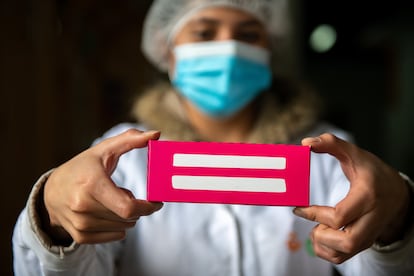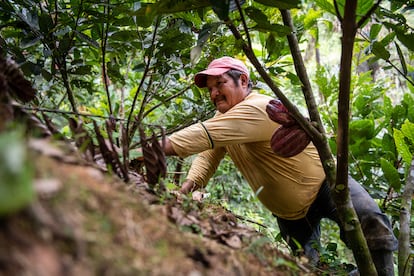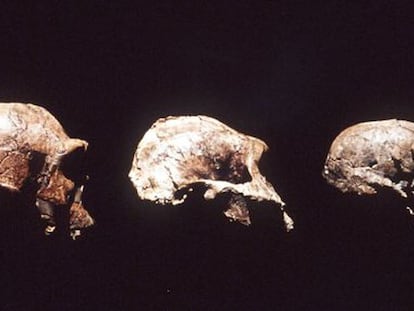Can blockchain make chocolate more just?
Producers in the Ecuadorian Amazon found that consumers are willing to pay more for cocoa that uses transparent supply chains

Rosalindo Guerrero has been clearing the ground all morning with her machete and planting saplings under the hot tropical sun. His farm is located in Ecuador’s Cordillera del Condor, in the transition zone between the Andes and the Amazon. The work is exhausting, which is why most of his children decided to migrate to the city, or found work with the mining companies that recently arrived to the area. Only his two youngest are still at home.
The family of small farmers survives on a traditional mix of companion crops they grow, mostly for self-sufficiency, on their eight hectares of land. The rest, mainly bananas and cocoa, is marketed through the Ecuadorian farming cooperative Apeosae. But market prices are low, and Guerrero has had problems with mold and fungi. This is why he decided to start growing more cocoa. “And then this project came along, the blockchain, and I was convinced,” the 55-year-old farmer says, wiping a few a few drops of sweat from his forehead with a tattered old towel.

More than 6,000 miles away, in Amsterdam, Guido van Staveren is hoping to put an end to the injustices of the international agricultural commodities market. “We have to rethink the 21st century economy,” the founder of the Dutch foundation Fairchain proclaims. With products such as coffee, bananas and cocoa, large trading companies tend to dictate prices, driving many producers to ruin and forcing them to resort to unsustainable monoculture or practices like child and slave labor. Van Staveren believes the time has come to change that for good. For this reason, he teamed up with the United Nations Development Programme (UNDP) in 2019 to launch a pilot project in Ecuador called #theotherbar. Guerrero signed up to participate.
The idea was simple: use blockchain to make the supply chain more transparent, then test to see if consumers are willing to pay more for products that include this information. The blockchain is a type of digital ledger; it records all transactions for a commodity, and every step is monitored and validated by all participants in the production and marketing chain.
In the case of chocolate, the supply chain records can be accessed using a QR code. At the end of the chain, the buyer has the option of downloading an app, scanning the code, and receiving information about the farmers who supplied the raw product. Buyers also have the option of digitally transferring a donation of €0.25 euros to the farmers, on top of the chocolate’s price point of €3 per 100-gram bar. These tips then go directly into the Ecuadorian cooperative’s account.
Climbing onto the roof to get signal
Apeosae’s cocoa collection center, where the beans are fermented and dried, is on the outskirts of the village of Panguintza in southern Ecuador. Internet reception there is unreliable, especially when it rains. “To send the data to the office, sometimes we have to climb up on the roof,” says 24-year-old Alex Jiménez, who oversees the center’s operations. Jiménez is enthusiastic about the project: “If we can bring farming and technology together and get better prices, we might be able to keep young people on the farms.”
So far, agriculture has been losing the race against mining. The area is full of copper, gold and silver deposits, and Chinese and Swedish-Canadian companies exploit the resources with open pit mining, while local entrepreneurs search for gold in the river valleys. Deforestation has increased in recent years. For small farmers, this poses two major problems: they can barely find enough workers for the harvest, and due to the mining, their products are sometimes contaminated with cadmium and other pollutants and are rejected by buyers. This then triggers a vicious circle of destruction: discouraged farmers often sell their plots to companies that deforest the land to plant monoculture crops like bananas, balsa wood or palm oil. Deforestation in turn accelerates climate change, leading to more pests and landslides, and ruining the livelihoods of more small farmers.
From Apeosae’s warehouses in Panguintza, the blockchain cocoa, already dried and packed into bags, is transported to the Hoja Verde chocolate factory in Quito, the country’s capital. There, in the cool Andean highlands, they produce two varieties for Fairchain: a dark chocolate and a milk chocolate.
Hoja Verde has produced nearly 20,000 bars for the Dutch foundation. Fairchain says that local value creation is an important element in achieving their goal of keeping 50% of the chocolate’s retail value in producing countries. At present, however, the farmers are far from reaching that large of a share, and currently retain just 3% to 7% of the chocolate’s final sale price. From the warehouse in Quito, the finished bars are shipped in transport containers to Amsterdam. Fairchain then registers receipt of the product digitally, and prints a unique QR code for each individual bar.
A boost to the local economy
For Nora Ramón, the cooperative’s manager, the experience has been largely a positive one: thanks to blockchain marketing, the collective earned an additional €6,000 from the increased sale price of the cocoa. “We convinced the UN to buy cocoa saplings from one of our cooperative members who runs a nursery,” says Ramón. “These tree varieties are much better adapted to the humid climate of the Amazon and are less susceptible to fungal diseases. We promoted local research, and the money stays in Panguintza’s local economy.” Ramón adds a caveat to the rosy picture: the software used by Fairchain costs €12,000. “For now, we can’t afford it,” she says.
For Fairchain, the experiment has been a resounding success. The chocolate sold out within a few months, and nearly half of all buyers activated the QR code, with 90% of those opting to pay an additional tip to the farmers. Consumers under the age of 25 were especially enthusiastic. But financially, the project would not have been possible without outside support. According to Guido Van Staveren, Fairchain and the UN Development Programme invested around €400,000 in the project — a sum far beyond the grasp of a farming cooperative in a developing country.
Fairchain’s local manager, Jorge Suescún, believes blockchain will soon be the global standard. If so, this will mainly be due to new European regulations on corporate responsibility and supply chain transparency. Large food companies have yet to join Fairchain, however, and Suescún is betting that organizations specializing in fair trade and organic products will get on board first. “Blockchain has the potential to replace all these labels,” he says. For cooperatives, that idea is attractive, since such certifications are often quite expensive. If a single production block were to contain information from several different certifications, it could lower the product’s overall cost.
Blockchain can accumulate various types of information on labor conditions and production practices, but it cannot replace inspection visits to ensure compliance with these standards. This is why the German “Fairtrade” label, for example, has yet to be incorporated into the system. “Blockchain is ultimately just a technological tool, not a panacea,” says William Crumpler, a technology expert at the Center for Strategic and International Studies in the United States. “It helps protect data, but it can’t guarantee that the data has been entered correctly.” In the hands of unscrupulous actors or institutions, Crumpler warns, the blockchain could even be used to legitimize corrupt data at the source — for example, in cases where land has been obtained through forced displacement and with the help of corrupt state agents.
What needs to change more than anything, says Carla Barboto, co-founder of Ecuadorian chocolate producer Pacarí, is the entire system of world trade. “Prices are determined based on the final sale to the consumer, not from what a producer needs to survive,” she says. Since 2002, Pacarí has been working to reverse that logic with its premium, high-dollar fair trade chocolates. The company has several certifications, and in Europe, a 50g bar sells for €3.50 — more than double the price of #theotherbar. “For the time being, blockchain would only incur an additional cost for us, without providing any other benefits or additional profits,” Barboto says.
Tu suscripción se está usando en otro dispositivo
¿Quieres añadir otro usuario a tu suscripción?
Si continúas leyendo en este dispositivo, no se podrá leer en el otro.
FlechaTu suscripción se está usando en otro dispositivo y solo puedes acceder a EL PAÍS desde un dispositivo a la vez.
Si quieres compartir tu cuenta, cambia tu suscripción a la modalidad Premium, así podrás añadir otro usuario. Cada uno accederá con su propia cuenta de email, lo que os permitirá personalizar vuestra experiencia en EL PAÍS.
¿Tienes una suscripción de empresa? Accede aquí para contratar más cuentas.
En el caso de no saber quién está usando tu cuenta, te recomendamos cambiar tu contraseña aquí.
Si decides continuar compartiendo tu cuenta, este mensaje se mostrará en tu dispositivo y en el de la otra persona que está usando tu cuenta de forma indefinida, afectando a tu experiencia de lectura. Puedes consultar aquí los términos y condiciones de la suscripción digital.










































